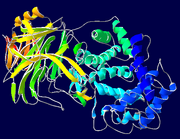Q Is there a procedure, besides spinning down, for preparing extremely viscous synovial fluids for testing? Is it acceptable to report "unable to analyze, fluid too viscous"?
A The specimen should be collected aseptically in three or four tubes:
1. A plain tube for gross examination and clotting.
2. An anticoagulated tube (EDTA or heparin) for cell counts. The sample should be collected in sodium heparin or liquid EDTA only.
3. A sterile tube for microbiological studies.
If the fluid is viscous, hyaluronidase lyophilized powder (Type V from sheep testes from Sigma H6254) should be used to treat a portion of the viscous fluid for cell counts. If the specimen is collected with heparin, a portion should be transferred to an EDTA tube, and a pinch of the solid hyaluronidase powder should be added to help liquefy the viscous fluid.
Body Fluids, third edition, by Carl Kjeldsberg and Joseph Knight includes a good reference procedure. (1)
--Robert M. Nakamura, MD
Chairman Emeritus and Senior Consultant
Department of Pathology
Scripps Clinic
La Jolla, CA
Reference
1. Kjeldsberg CR, Knight JA. Body Fluids. 3rd ed. Chicago, IL: ASCP Press; 1993.
Edited by Daniel M. Baer, MD
MLO's "Tips from the Clinical Experts" provides practical, up-to-date solutions to readers' technical and clinical issues from a panel of experts in various fields. Readers may send questions to Dan Baer by e-mail at tips@mlo-online.com.
COPYRIGHT 2005 Nelson Publishing
COPYRIGHT 2005 Gale Group



